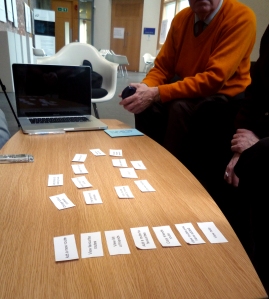Brilliant visualization of the differences between bottom-up and top-down Source The User Experience Hierarchy of Needs Source
So week two has begun and we’ve now had both of our weekly tutorials. I’ll start with the first one and leave the second one (a pressure project no less, so stay tuned) to another post.
The week begun with being introduced to two different approaches one can take with a project; the top-down approach and the bottom-up approach. The top-down way of looking things gives one a broader perspective on the whole of the project. It is about looking at the big picture as well as the wider context of it all. And not surprisingly bottom-up is quite the opposite driving the project through looking at details and being informed by the nitty-gritty of it all. As one might imagine neither is better than the other and really neither can excel without the other. The challenge comes from being able to join these in a way that works for your project.

This reminded me a lot of a model that I’ve recently read about called the User Experience Hierarchy of Needs. This is a model conceived by Stephen P. Anderson and explained more throughly in his book Seductive Interaction Design. Even though it has been conceived to try and shift focus from tasks to experiences, in a way it also gives two choices on how to approach a project. If you start from the bottom of the pyramid and work your way up it gives you an opportunity to focus on the tasks and products and features. Where as if you start from the top and then work your way down you shift your focal point to the experiences and to the people, the activities and the context in which these two come together. Which one is more appropriate might depend on the project, but it’s interesting to look at it as a way to get you thinking at your project in two completely different ways.

So, back to the actual tutorial. A part of mondays agenda was starting to think about what might drive our own projects; could it be technology, people or a certain material or a process we were interested in. As you might have gathered from my previous posts I’ve been kind of treading water until now and so this kind of exercises that force me to make decisions have proved to be very useful. From the get go it’s been quite clear to me that people will play a great part in forming my project. I feel a certain kind of, well for want of a better word, connection, to user centered design. I want to work with people and it’s definitely something that motivates me and inspires me. So it would be foolish not to incorporate this into my project. As for the technology I have no clue. I want the project to have a strong digital aspect but I’ll have to give this a good thought before I’ll be able to pin down a certain technology that I’ll want to use. I definitely want to try and merge both bottom-up and top-down thinking into it, trying to keep the big picture always in mind but also allowing details the space to shape it. I’m also more interested in shaping an experience but I can’t forget that in order to create an experience worth having the project needs to have firm underlying structure.
From the tutorials an excellent suggestion was made on how I could start my look for the initial starting points: roleplaying different decision. So here I could make certain decisions about my project, say that it’ll use smartphone technology and play around with that idea, see where it takes me and how it feels. These don’t have to be final decisions but rather make me think about all the different choices and how I feel about them and what might be the right direction for me. I really like the idea of this and have already decided to dedicate some time to this during this week. The goal is to try and form the first stepping stone on my route to writing the brief.
Mira Kirvesmaki
Design with heart

-
Subscribe
Subscribed
Already have a WordPress.com account? Log in now.
